The race to field the most advanced stealth fighter engines in the world
- By Alex Hollings
Share This Article
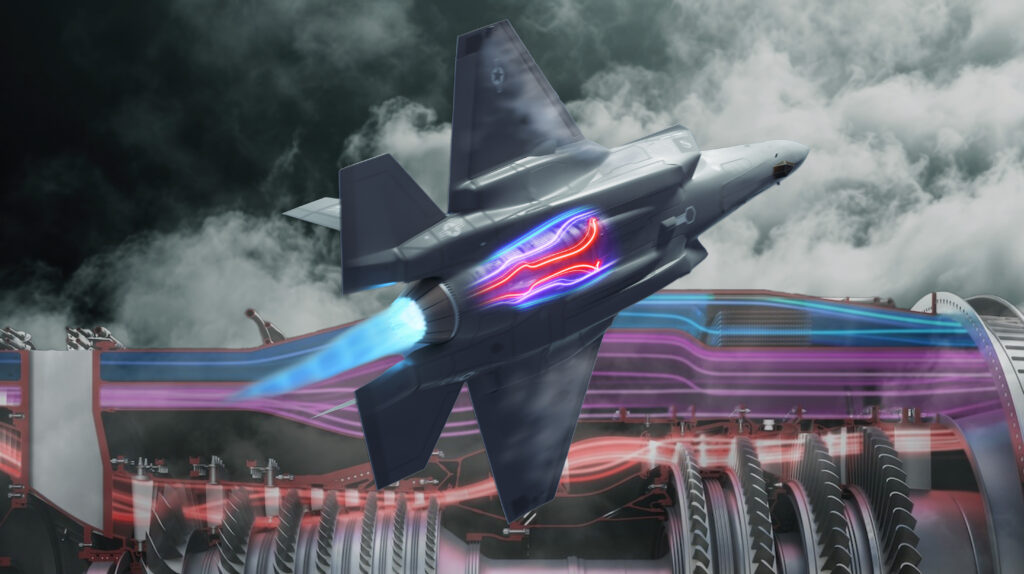
Despite a popular focus on stealth – and to a lesser extent, data fusion – in today’s fighters, America’s turbofan advantage is just as valuable in setting American fighters apart through a combination of high power output and carefully crafted radar and infrared detection mitigation.
A stealth fighter is only as good as the engine powering it, and until now, only the United States has been able to effectively field these sorts of advanced engines in sufficient numbers to equip a high-end fighter fleet.
But in April 2023, the Aero Engine Corporation of China (AECC) announced that serial production of China’s advanced WS-15 turbofan engine was finally set to begin, marking what is expected to be a significant leap in capability for the nation’s single in-service stealth fighter, the Chengdu J-20. The engine is expected to increase the power output pilots have on tap, the aircraft’s overall combat radius, and most importantly, stealth against both radar and infrared detection.
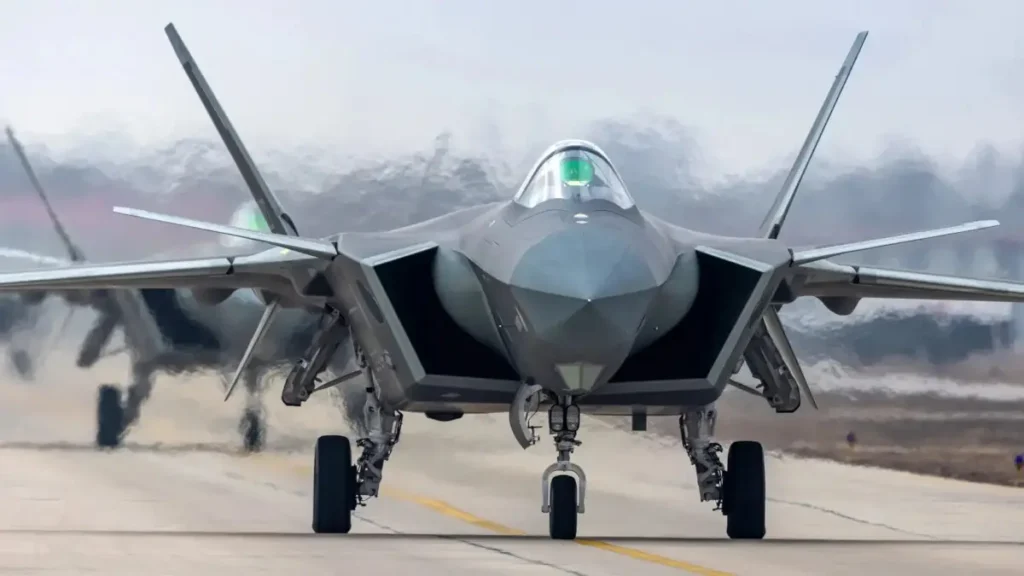
And even amid its stalled invasion of Ukraine and stagnating economic sanctions, Russia managed to follow suit in December – announcing that its homegrown 5th generation engine, known as the Saturn AL-51 in most international circles, would also see serial production in 2024. Just as with China’s WS-15, the inclusion of these new engines will give Russia’s Su-57 a palpable boost in combat performance and stealth – something the Russian 5th-generation jet struggles with more than any other jet of its class.
While the precise capability limits of these new Russian and Chinese turbofan engines are subject to some debate, the broad consensus is clear: the strategic advantage America’s advanced turbofan technology has long provided is rapidly eroding. But this won’t likely last.
Related: Which will be the company that will build America’s next stealth fighter?
The F-22’s groundbreaking engine
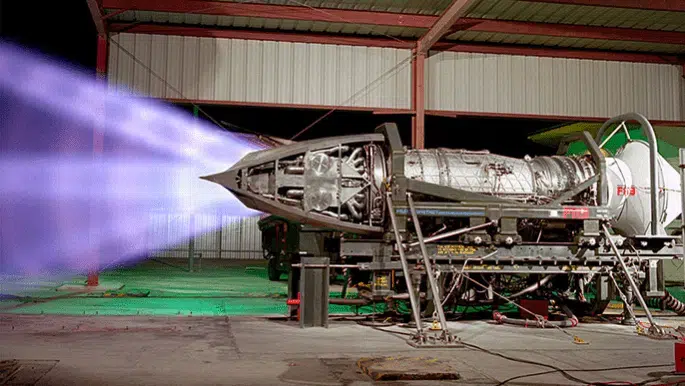
Development on Pratt & Whitney’s F119 turbofan engine, which would come to be the engine of the world’s first 5th generation fighter, began in 1983, with prototyping contracts awarded to both General Electric and Pratt & Whitney.
General Electric had been the clear frontrunner in fielding engines for stealth aircraft, having already successfully modified their F404 turbofan engines, originally developed for the F/A-18 Hornet, for stealthier duties in the F-117 Nighthawk. The company had also developed the B-2 Spirit’s F118 turbofans which were non-afterburning and much stealthier derivatives of its F110 engine that has seen service in several fighters over the years, including the F-16, F-15E, and new F-15EX.
GE’s incredibly forward-leaning YF120 engine design was the higher performer, thanks in large part to its groundbreaking variable cycle design that used bypass tubes to allow the engine to function like a low bypass turbofan during most flight regimes, but transition to nearly complete turbojet functionality at high altitudes where it would be more efficient.
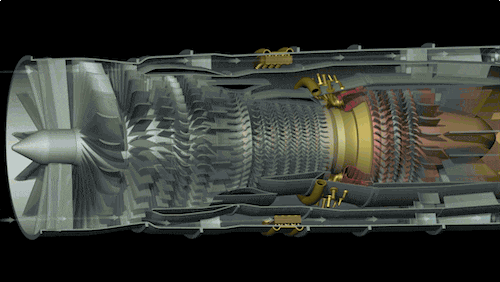
But this high-technology approach came with a similarly high weight penalty and far more complexity than Pratt & Whitney’s more grounded, though still groundbreaking, proposal.
Pratt & Whitney’s YF119 may have been a bit more pragmatic, but it came with no shortage of technological advances. The YF119 leaned on previous developments derived from the U.S. Army’s Advanced Turbine Engine Gas Generator (ATEGG) program to inform turbine fan-blade shaping for optimal efficiency, and the Joint Technology Demonstration Engine (JTDE) program, to reduce the number of stages required for the same power output. Thus, Pratt & Whitney’s revolutionary new engine design made it possible to reduce the number of compressor stages from 10 in engines like the F100, to just six, allowing for a 22 percent increase in thrust output in an engine design with 40 percent fewer parts.
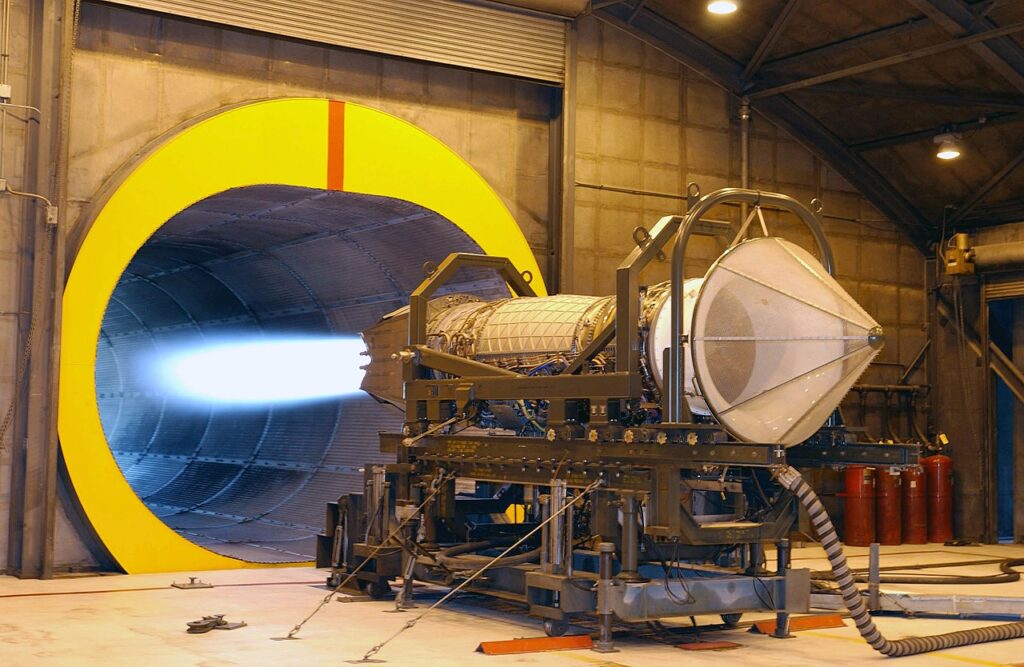
Their YF119 design’s multivariable, linear quadratic regulator control system allowed for extremely precise engine control across all flight conditions, maximized efficiency and performance in nearly all circumstances, and – while not often seen as sexy enough to celebrate – came with a proactive management toolset and new reliability tracking systems like an in-line oil-debris monitoring sensor to assess engine wear in real time to further streamline and reduce maintenance and repair requirements.
Its three-zone afterburner placed its fuel injectors in thick, curved vanes meant to block line of sight to the turbine; those vanes were coated in early ceramic-based radar-absobent material to further reduce radar detection. The engine nozzles, which offer ±20° thrust vectoring for incredible aerobatic performance, greater control at high altitudes, and more effective flying at higher angles of attack, used wedge-shaped flaps to reduce their radar return, while also facilitating the active mixing of outgoing engine exhaust with ambient air to reduce heat (or infrared) detectability as well.
Related: America’s NGAD fighter emerged from a classified billion-dollar X-Plane
The most powerful fighter engines on the planet
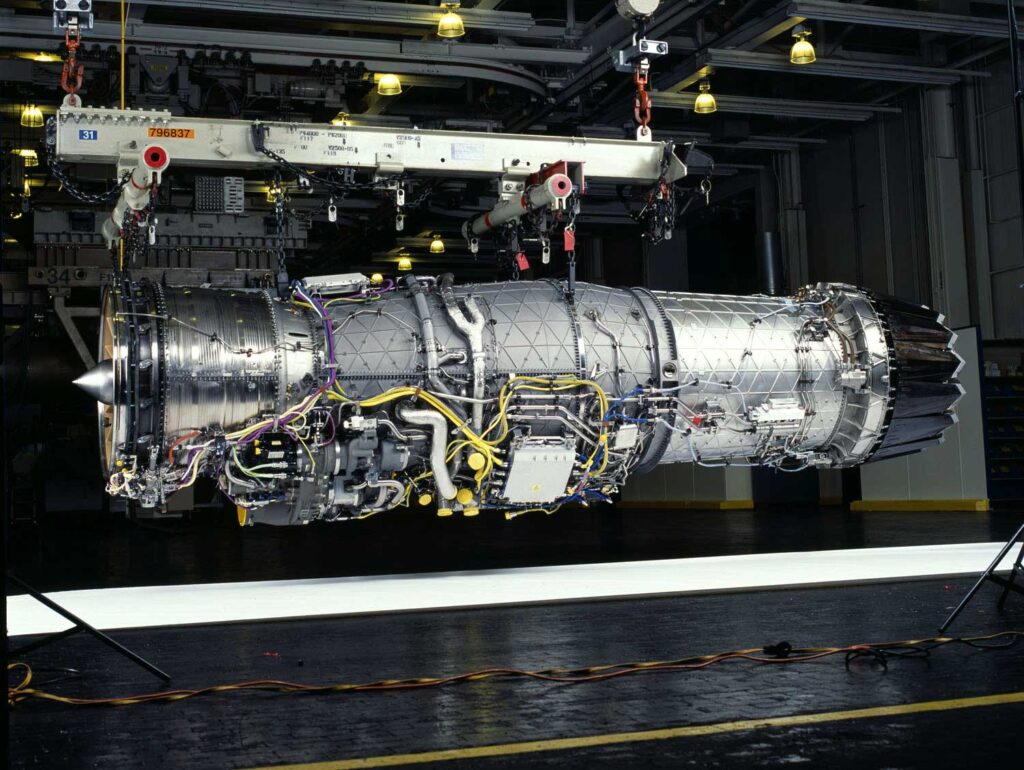
When the YF-22 and its pair of YF119 engines matured into the F-22 and the F119s, they represented the most advanced airframe/engine combination of any fighter in history, with unprecedented thrust-vectoring maneuverability and what Pratt & Whitney claimed was twice the thrust of current state turbofans while in supersonic flight.
With greater power output under afterburner than the J58s that powered the SR-71 Blackbird, these new F119 engines could pump out more thrust under standard military power – some 26,000 pounds each – than the F-15C’s engines could with their afterburners engaged. In fact, the F-22 has enough power to not just maintain supersonic speed under military power, but to accelerate beyond Mach 1 without using its afterburner at all. It can even maintain speeds as high as a reported Mach 1.8 while “supercruising” (or flying without afterburner).
Put simply, the F119 was every bit the performer the F-22 came to be, offering the United States a decisive airpower advantage.
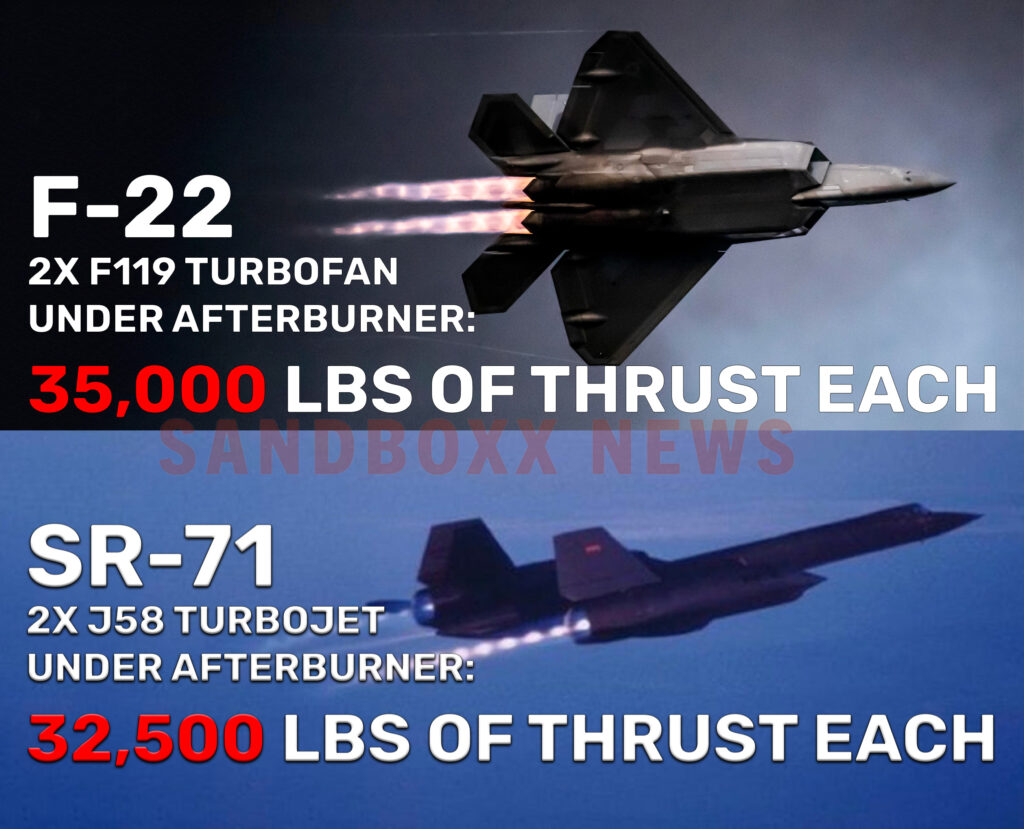
In 2009, the F119 became the basis for America’s next serial production 5th generation engine entry, the Pratt & Whitney F135. This engine powers all three variants of the F-35 Lightning II, with Rolls Royce added into the mix to supplement the F-35B’s vertical-lift system. The new F135 turbofan engine offers even greater power output than the F119, with an astonishing 28,000 pounds of thrust under military power and 43,000 under afterburner. This provides the brute force necessary to give the single-engine Joint Strike Fighter a respectable thrust-to-weight ratio of about 1.07 with a standard combat load.
Despite suffering similar technical setbacks to the Joint Strike Fighter effort as a whole, the engine has emerged as not only the most technologically advanced turbofan in service today, but among the most reliable reaching a 95 percent fleet-wide engine readiness rate in 2019, and seeing more than a 50 percent reduction in production costs over the first 500 engines produced. In 2024, the F135 will receive a significant upgrade meant to provide greater cooling to allow for more electrical energy production; this will support a bevy of new systems and weapons that will come with the F-35’s Block 4 Upgrade.
But as capable as these Pratt & Whitney engines truly are, they are no longer without peers.
Related: Lockheed Martin has now built 1000 F-35s
Russia’s AL-51
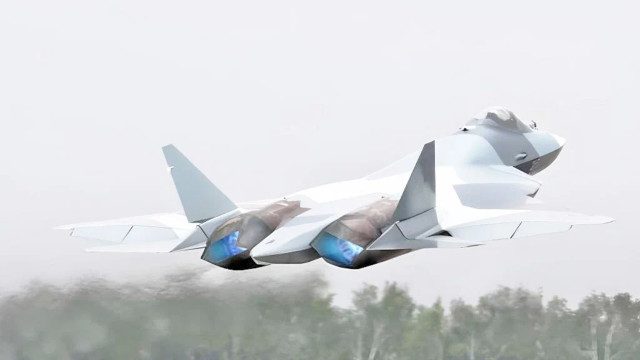
Russia’s premier stealth fighter, known today as the Sukhoi Su-57 Felon, has had a troubled developmental and production cycle that has resulted in a platform widely recognized as the worst of its generation. Yet, truth is that direct comparisons to incredibly capable aircraft like the F-22 has, to some extent, skewed perceptions of what is otherwise a significant leap forward in Russian aviation technology.
Although the Su-57’s footprint is estimated to be thousands of times larger than the F-22 on radar screens, it is estimated to be anywhere from 16-30 times smaller on radar than its predecessor, the Su-27 marking a significant design improvement even if falling well short of its foreign peers. Nonetheless, stealth is just one of many areas the Su-57 program has struggled. While production volume is easily this aircraft’s primary shortcoming (with fewer than 20 Su-57s in service to date), Russia’s longstanding 5th-generation engine woes may come at a close second.
The handful of Su-57s Russia has in service today are powered by an updated iteration of the same thrust-vectoring Al-41F1 engine that also powers the country’s 4th generation Su-35S. This turbofan has been flying since the 1980s, though it saw the inclusion of an updated engine control system before being fitted into the Felon.
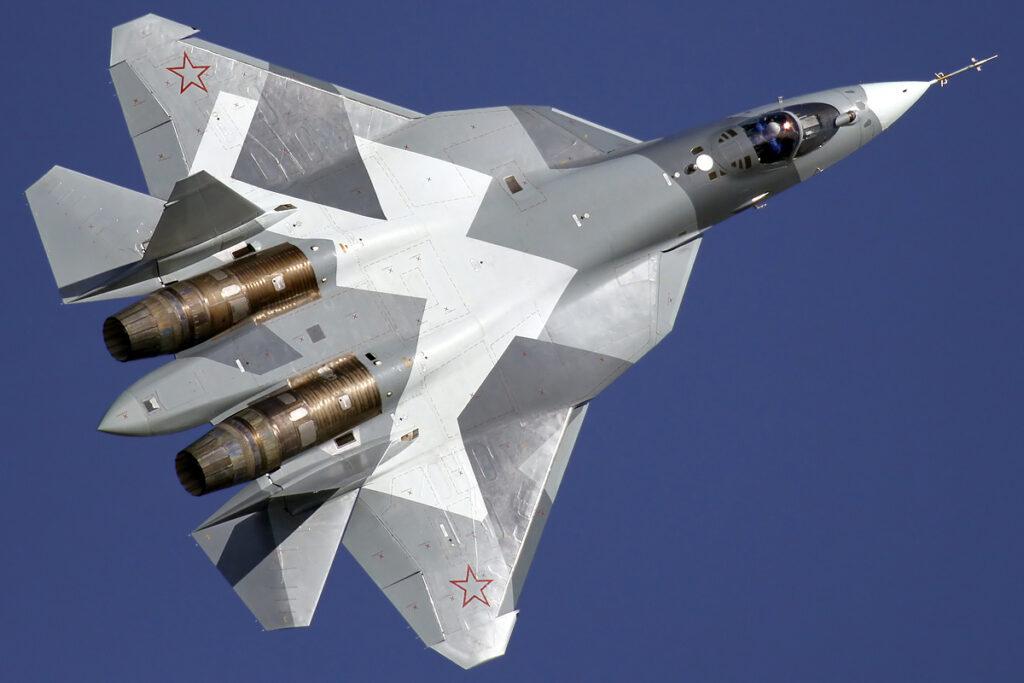
Though dated, these engines produce a respectable amount of power under afterburner: Each turbofan housed in the Su-57’s fuselage is capable of pumping out some 32,000 pounds of thrust – nearly on par with the F119s powering the F-22. However, the Russian engine can’t keep up nearly as well until military power, boasting just 19,900 pounds of thrust without the afterburner, as compared to the F119’s whopping 26,000 pounds.
As a result, Russia claims the Su-57 can supercruise, though its performance would fall short of earning that title by American standards. The U.S. Air Force considers “supercruising” to be flying without an afterburner at speeds of Mach 1.5 or faster, as several American 4th generation fighters can maintain lower supersonic speeds for a time without it. Russia, however, considers any supersonic flight without afterburner to be “supercruising,” and as such, claims the title despite the Su-57 likely only being able to reach Mach 1.3 or so in dry flight.
Worse still, these engines were not designed for stealth applications, and as such, render Russia’s stealth fighter far more detectable against both radar and infrared systems thanks to the omission of radar return-mitigating nozzles or active-mixing of outgoing exhaust with ambient air. Put simply, the Su-57 may be a capable fighter, but it isn’t much of a stealth fighter, and its engines are a big part of that problem.
That’s where Russia’s AL-51 finally comes in. Although the Su-57 began flying in 2010, the engine meant to power it didn’t begin formal development until 2015. These new engines are broadly claimed to be on par or even more advanced than American 5th generation engines by Russian media outlets, though to date, there is very little evidence to substantiate these claims. Russia plans to finally start sticking them in airframes later this year.
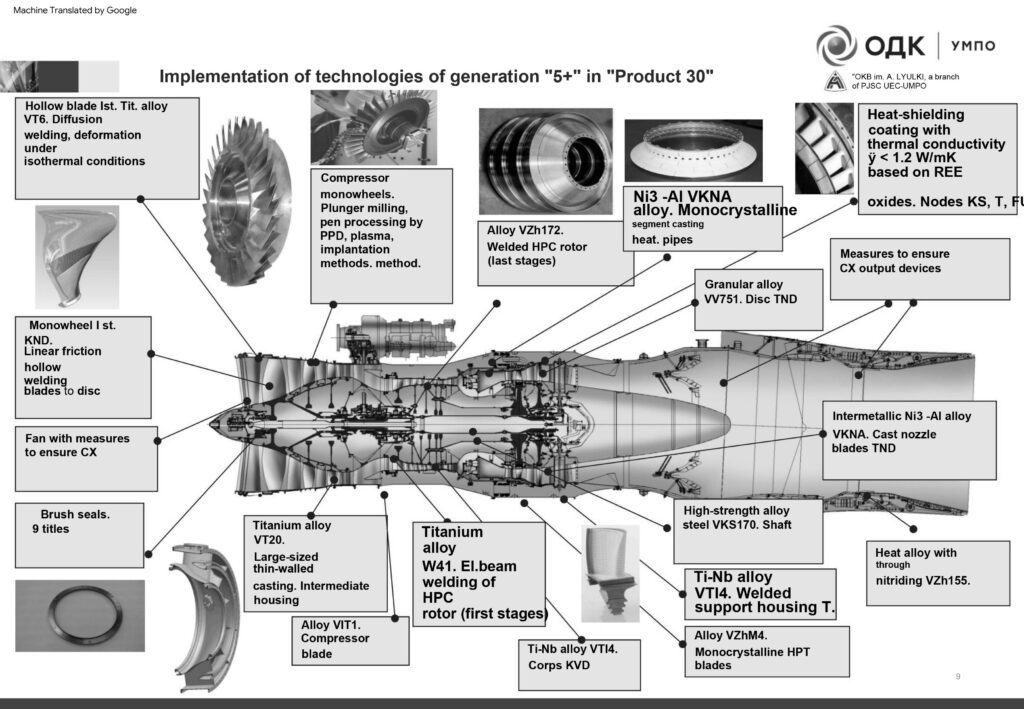
Russian reports highlight that these new AL-51 engines will be powerful. Russian-friendly media outlets report their non-afterburner power as approximately 24,300 pounds of thrust, just shy of the Raptor’s, but their afterburning power at a jaw-dropping 37,500 pounds. Since the program began, Russian media has claimed significant improvements in maintainability and fuel efficiency as well, which seems in keeping with the developmental stage of the effort, though interestingly, there has been very little official discussion of any stealth improvements fielded in the new engine design beyond incorporating new 2D thrust vectoring nozzles in place of the existing 3D nozzles.
Of course, all of these claims have to be taken with a grain of salt, as independent media doesn’t exist within Russia and the country has a well-documented history of exaggerated military technology. Yet, it does seem likely that these AL-51 engines will help the Su-57 step even further ahead of the 4th generation, even if it remains lagging behind its 5th-generation counterparts.
Related: Fighter Comparison: Russia’s stealth fleet ranks 11th in the world
China’s WS-15
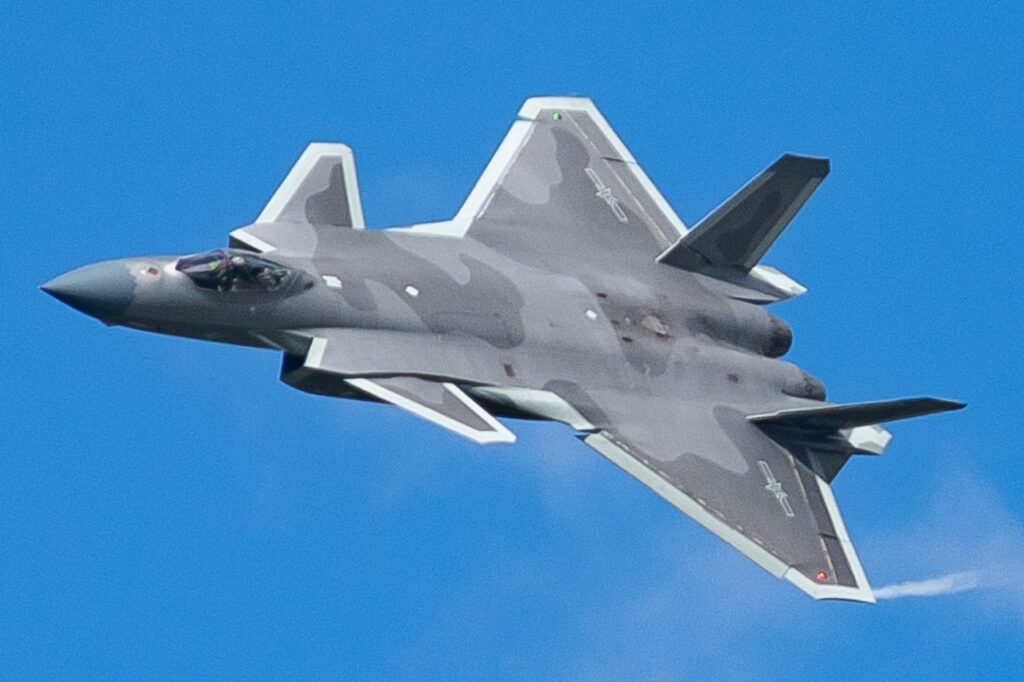
Similar to Russia’s Su-57, China’s growing fleet of stealth fighters has, to date, been powered solely by updated 4th-generation engines that limit stealth and performance. The first J-20s were all powered by Russian-sourced AL-31FM2 engines, until 2015 when China began transitioning toward its own equivalent, dubbed the WS-10. It wasn’t until 2022, however, that China’s long-troubled WS-15 engines meant for these fighters finally made it into flight trials.
Unlike Russia’s stealth fighter fleet, which amounts to little more than parade fodder, China’s growing fleet of Chengdu J-20 stealth fighters now outnumber American F-22s and are understood to outperform the Russian fighter in terms of stealth of overall avionics, despite falling short of the technological bar set by the F-35 and F-22. Also unlike the Su-57, the addition of more advanced and capable engines in China’s J-20s represents more than just headline fodder… and could offer a legitimate increase in strategic capability.
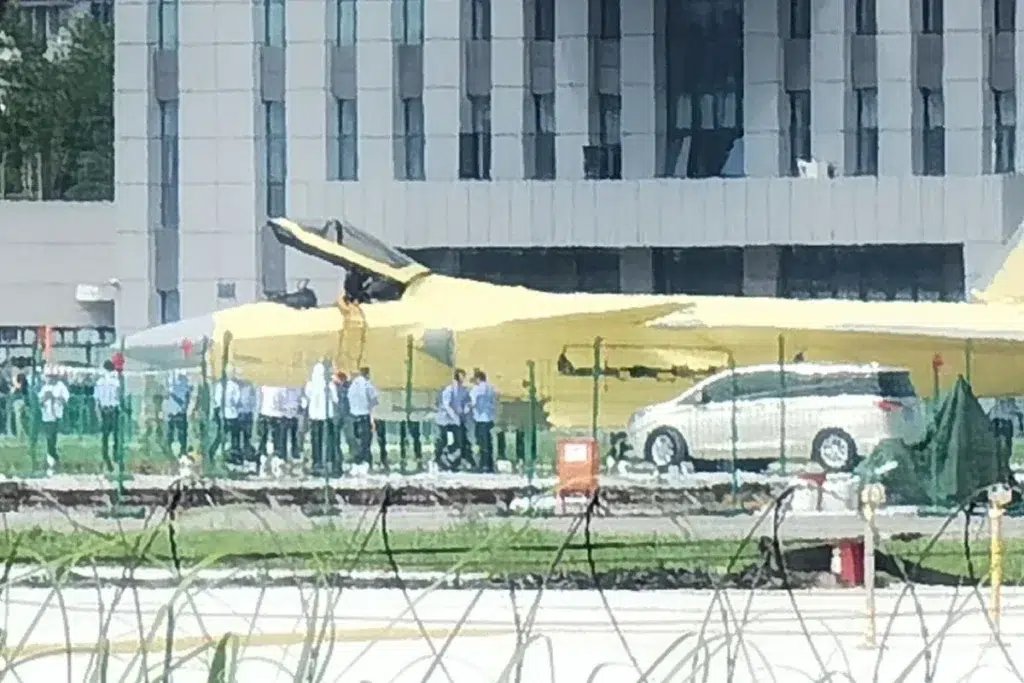
Details about the WS-15 development are murky thanks to an utter lack of transparency in Chinese state-controlled media, but it is believed to have started back in the 1990s. Various media reports over the years have indicated that these new engines will produce 36,000 pounds of thrust, or maybe even 40,000 pounds, under afterburner, making the J-20 the most powerful stealth fighter on the planet. Media reporting also suggests improved fuel efficiency and supercruising capabilities to boot.
But more important than an increase in power output are the undisclosed details about improved stealth. Assuming that China has invested in not just engine performance, but radar and infrared detection mitigation, one could expect these new engines to make the most potent adversary stealth fighter on the planet even more capable. And while it can’t be said for certain that these new engines can match Pratt & Whitney’s F119 and F135 in terms of low-observability and performance, if Chinese claims are to be believed, the WS-15 may well be a legitimate peer to the F119.
But Uncle Sam isn’t taking this one lying down…
Related: Offsetting China’s stealth fighter advantage: An in-depth analysis
Another turbofan revolution: Adaptive Cycle Engines
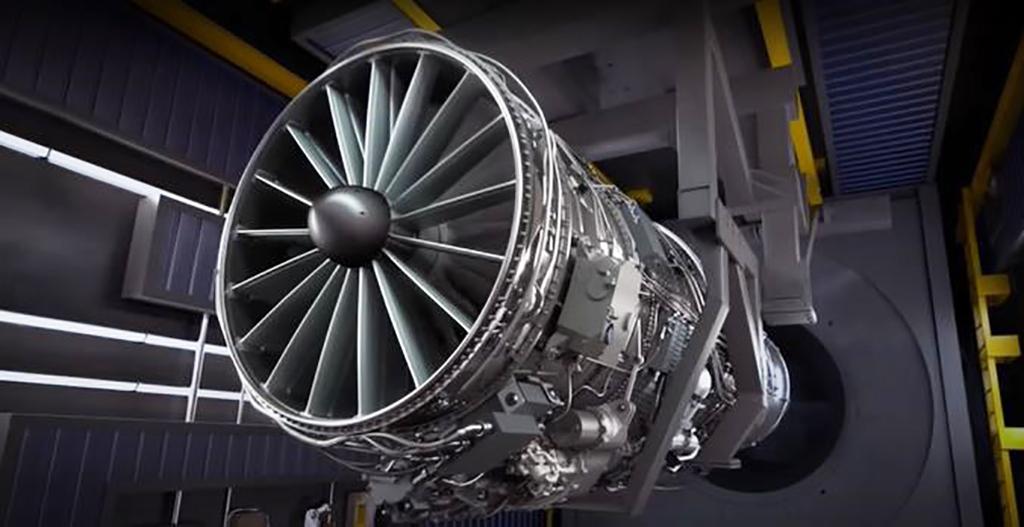
Back in 2016, the Air Force Life Cycle Management Center’s Propulsion Directorate quietly awarded new developmental contracts to GE and Pratt & Whitney to field the next generation of turbofan engines with the intent of using them to power the next generation of stealth fighters.
Historically, every turbofan design has represented a variety of compromises – including the need to balance high-end power output against long-range efficiency. As such, the turbofans designed for cargo aircraft, spy planes, and the like tend to prioritize fuel economy over power generation, while fighter engines prioritize high-end performance over range. Adaptive Cycle engines like those under development within the AETP program, however, aim to throw that compromise away.
“The goal for the Air Force was to develop the next-generation fighter engine architecture and technologies to provide a generational step-change in combat propulsion capability,” David Tweedie, GE Edison Works’ General Manager of Advanced Combat Engines, told Sandboxx News.
This effort, dubbed the Adaptive Engine Transition Program (AETP), sought a modest 10 percent increase in thrust over the F135 that powers today’s F-35, but alongside a 25 percent increase in range and a substantial increase in thermal management.
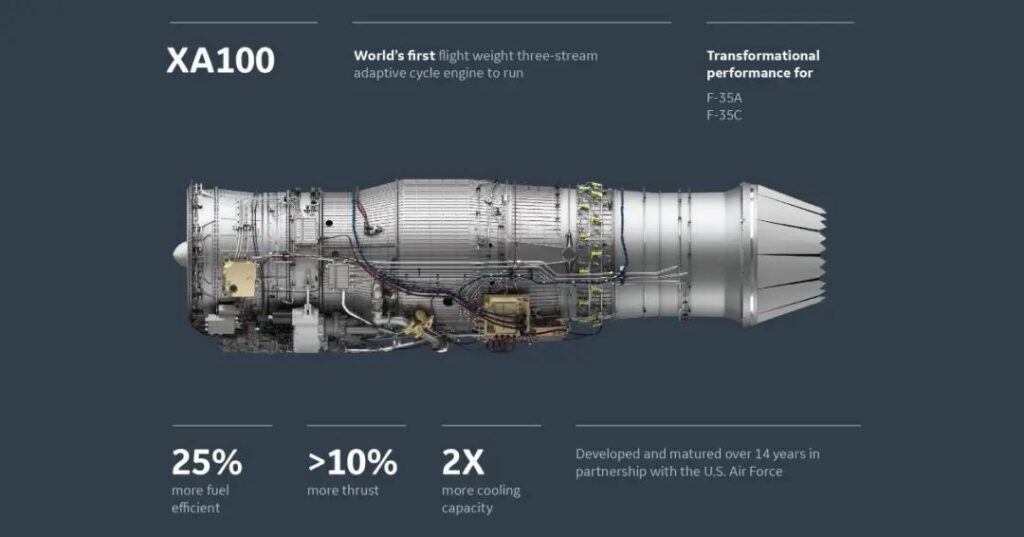
To accomplish that, these new engines are designed to operate in different functional “modes.” When the pilot needs the engine’s peak performance in combat, they can lean hard on the throttle and the engine’s management system will take its cue to switch into heavy-burning high-thrust mode for max power. Conversely, while on a patrol, the engine will stay in its high-efficiency, low-burning mode to stretch the mileage or loiter time provided by each gallon of fuel.
In May 2021, GE’s XA100 adaptive cycle engine roared to life, immediately eclipsing the Air Force’s targets. According to Tweedie, they saw a greater than 10 percent increase in thrust throughout nearly the entire flight envelope, with as much as a 20 percent increase in some areas. But thrust isn’t the only area where the XA100 excels. Through operating in different propulsion modes, the engine also offered a huge boost in economy.
“When you translate that to what it means to the platform, it’s 30 percent more range or 50 percent more loiter time depending on how you want to utilize that fuel burn improvement. It’s a significant increase in acceleration and combat capability with the increased thrust,” Tweedie told Sandboxx News.
Five months later, Pratt & Whitney’s XA101 followed suit, calling its effort a success, but being less forthcoming with final figures.
But as promising as the increased power and range may be, GE’s claim of twice the thermal management of previous engines may ultimately prove more important.
Heat limits how much power fighter engines can produce. Engines like the F135 are capable of producing more power, but we limit their output because the heat that would be created in the process is so significant that it runs the risk of damaging the fighter’s fragile radar-absorbent skin, or even the fuselage itself. However, by offering twice the heat management, these new adaptive cycle engines could theoretically also produce twice the electrical power paving the way for directed-energy laser weapons and missile countermeasures, advanced new electronic warfare systems, and much more to be fitted on a jet.
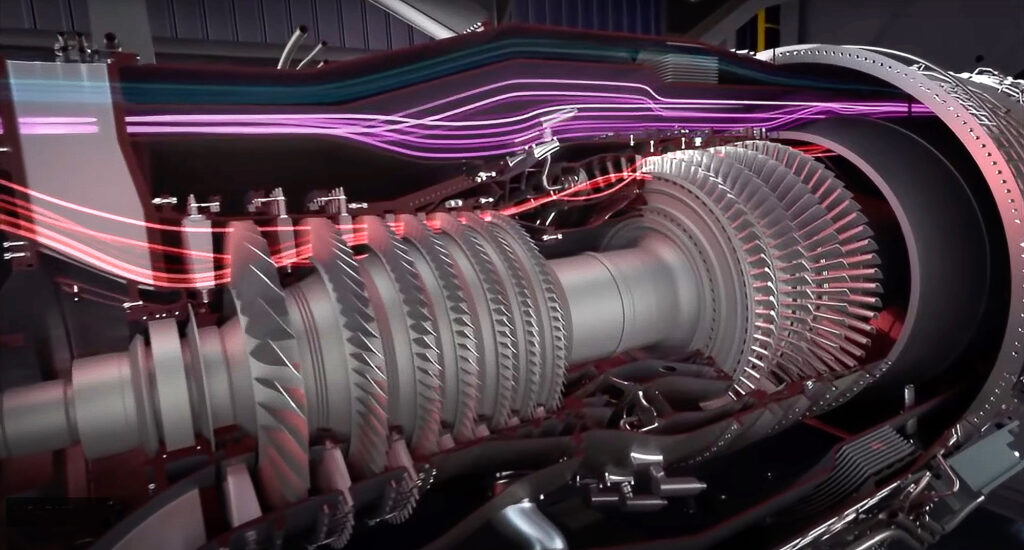
For a time, the Pentagon even assessed adding these advanced new engines to the F-35 as a part of its Block 4 upgrade; this would have been a boon to the U.S. Navy, which is working tirelessly to find ways to extend the ranges of its carrier-based fighters. Ultimately, the DoD opted for the less-expensive route of simply upgrading the existing F135.
In August 2023, John R. Sneden, propulsion director for the Air Force Life Cycle Management Center, explained that neither the XA100 nor the XA101 would be chosen to power America’s 6th generation fighters – instead, the same technology would be incorporated into even newer engines of a “different size.”
Sneden would not clarify if that meant larger engines (as engine designs have progressed in recent decades), but many within the aviation community believe that to be the case. Larger engines may well result in greater power output and the ability to carry larger payloads – both elements that America’s 6th generation fighter programs emphasize.
These even newer engines, Sneden said, will boast advanced composite and ceramic matrix materials to reduce weight and further bolster their heat management capabilities. They’re expected to be fielded in time to power the Next Generation Air Dominance Fighter as it cruises toward service at the end of this decade.
So, while China and Russia may finally be closing the gap on one of America’s most important (though little-discussed) stealth fighter advantages, the United States seems positioned to restake its claim as the undisputed leader in fighter engine technology in the not-too-distant future.
Read more from Sandboxx News
- Section 702: A controversial but necessary intelligence authority
- The uncertain origins of the military hand salute
- The A-10’s long-delayed retirement is rolling forward. What’s next?
- Diving into Iran’s intentions following deadly drone attack on US troops
- These are the wild F-15 variants we could have gotten
Related Posts
Sandboxx News Merch
-

‘AirPower’ Classic Hoodie
$46.00 – $48.00 Select options This product has multiple variants. The options may be chosen on the product page -

‘Kinetic Diplomacy’ Bumper Sticker (Black)
$8.00 Add to cart -

‘Sandboxx News’ Trucker Cap
$27.00 Select options This product has multiple variants. The options may be chosen on the product page

Alex Hollings
Alex Hollings is a writer, dad, and Marine veteran.
Related to: Gear & Tech
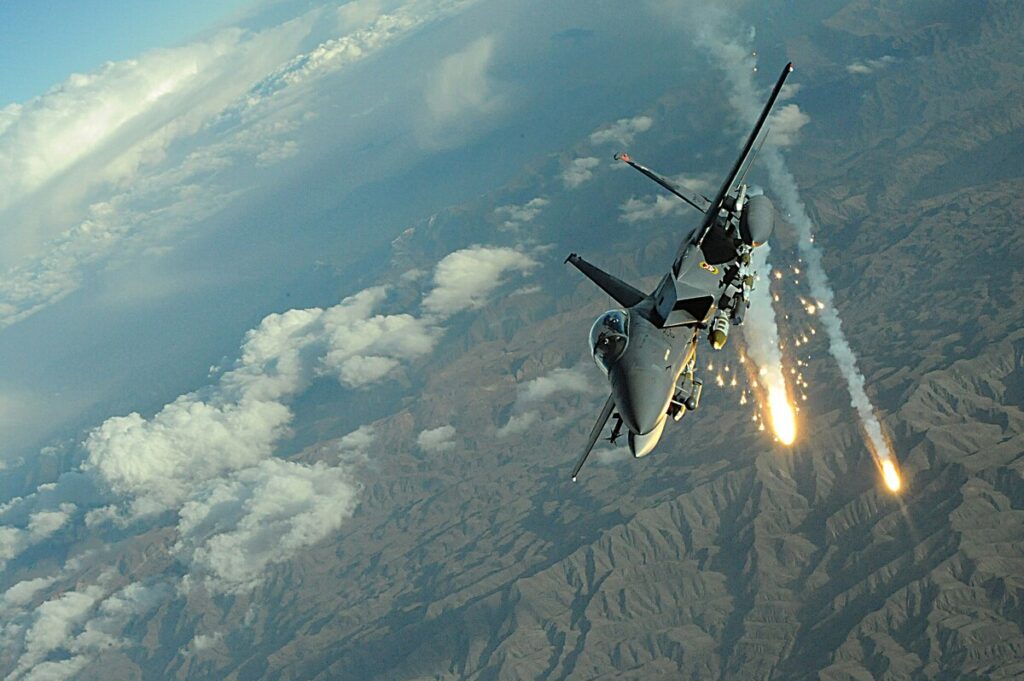
How an F-15E scored its only air-to-air kill… with a bomb

The military roots of Juneteenth and why we celebrate it
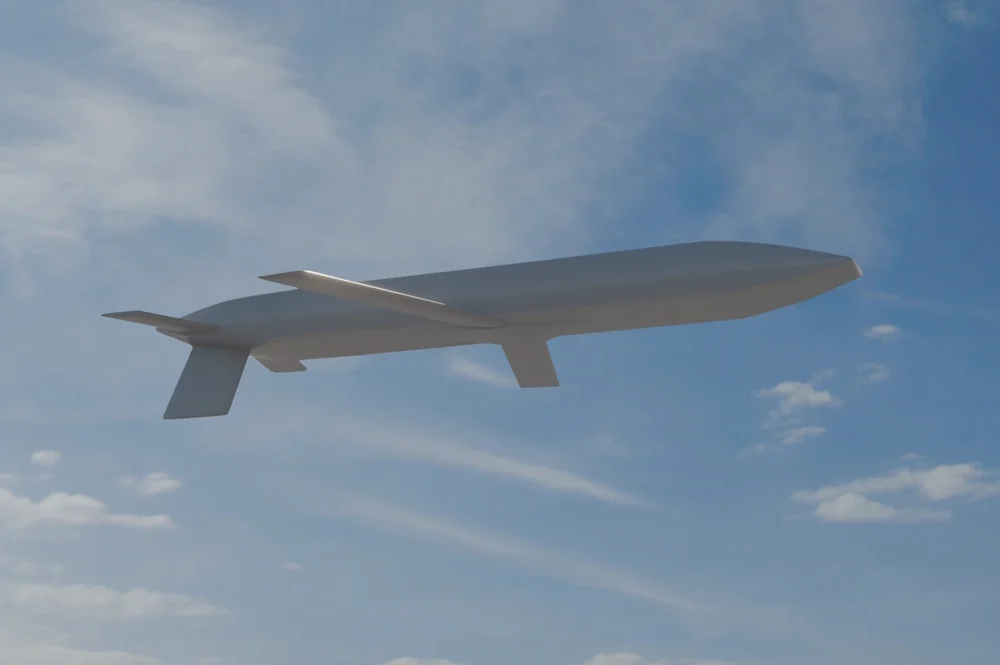
Air Force gives us a glimpse of its new AGM-181 LRSO nuclear missile
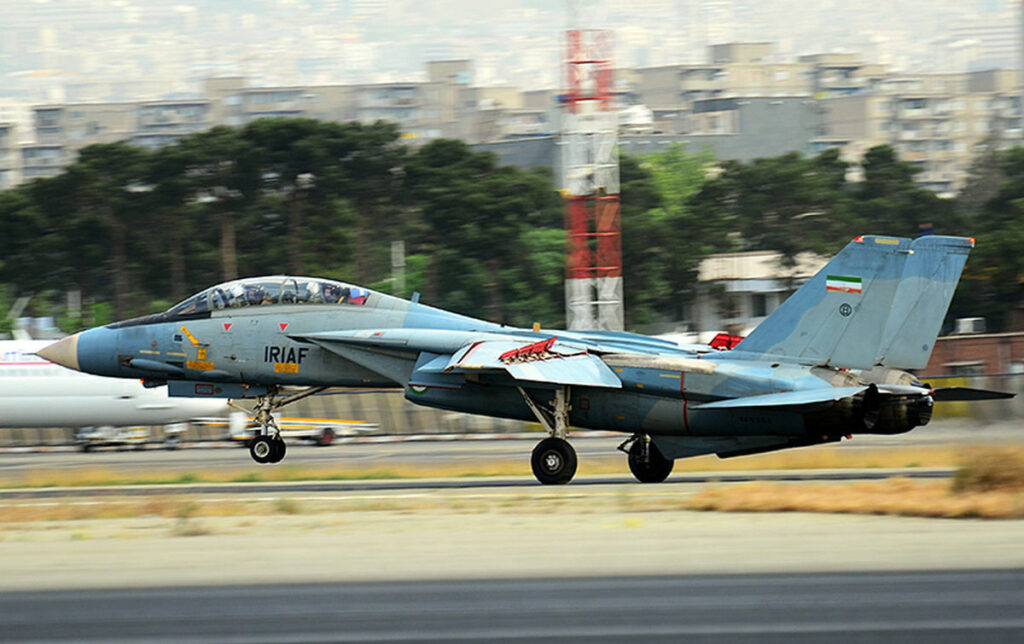
Israel wipes out Iranian F-14 Tomcats on the airstrip
Sandboxx News
-

‘Sandboxx News’ Trucker Cap
$27.00 Select options This product has multiple variants. The options may be chosen on the product page -

‘AirPower’ Classic Hoodie
$46.00 – $48.00 Select options This product has multiple variants. The options may be chosen on the product page -

‘AirPower’ Golf Rope Hat
$31.00 Select options This product has multiple variants. The options may be chosen on the product page -

‘Sandboxx News’ Dad Hat
$27.00 Select options This product has multiple variants. The options may be chosen on the product page
